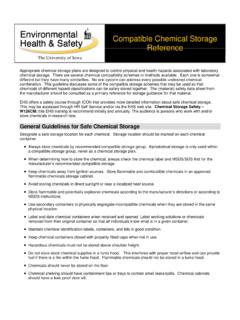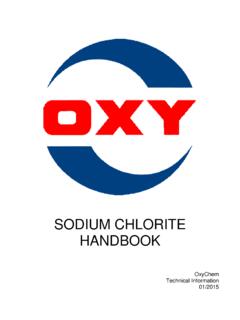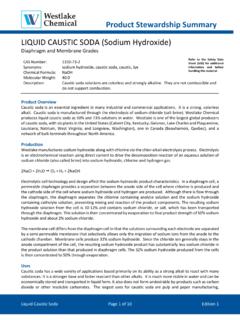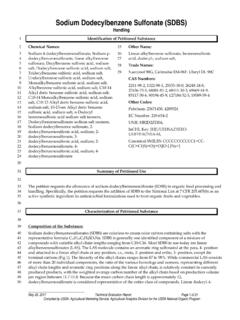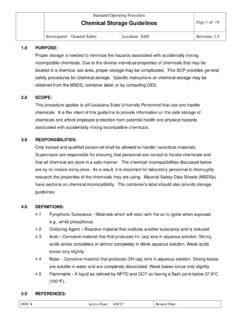Transcription of HDL Cholesterol Laboratory Procedure Manual
1 Laboratory Procedure Manual Analyte: HDL- Cholesterol Matrix: Serum Method: Roche/Hitachi Modular P Chemistry Analyzer as performed by: Collaborative Studies Clinical Laboratory University of Minnesota Medical Center Fairview-University Medical Center University Campus Minneapolis, Minnesota Contact: Dr. Jack Eckfeldt., Important Information for Users The Fairview -University Medical Center periodically refines these Laboratory methods. It is the responsibility of the user to contact the person listed on the title page of each write-up before using the analytical method to find out whether any changes have been made and what revisions, if any, have been incorporated.
2 HDL- Cholesterol in Serum NHANES 2007-2008 Public Release Data Set Information This document details the Lab Protocol for testing the items listed in the following table: Lab Number Analyte SAS Label (and SI units) LBXHDD HDL- Cholesterol (mg/dL) HDL_E LBDHDDSI HDL- Cholesterol (mmol) 2 HDL- Cholesterol in Serum NHANES 2007-2008 1. SUMMARY OF TEST PRINCIPLE AND CLINICAL RELEVANCE. Clinical Revelance High density lipoprotein (HDL) is the fraction of plasma lipoprotein with a hydrated density of to g/mL. It is composed of 50 per cent protein and 50 per cent lipids. Epidemiological data from the Framingham Heart Study has demonstrated an inverse association between HDL Cholesterol values and subsequent development of coronary artery disease in 50-80 year old subjects.
3 Those with low HDL Cholesterol levels were more likely to develop coronary artery disease than individuals with higher HDL Cholesterol levels. HDL Cholesterol functions as a transporter of Cholesterol from the peripheral cells to the liver. Here, Cholesterol is transformed into bile acids and excreted through the intestine via the biliary tract. Traditional precipitation methods require Manual addition of precipitating reagent, specimen vortexing, centrifugation and transfer of the resulting supernatant to a sample cup. In this method, HDL is directly measured in the untreated specimen. Principle: In this method a magnesium/dextran sulfate solution is first added to the specimen to form water-soluble complexes with non-HDL Cholesterol fractions. These complexes are not reactive with the measuring reagents added in the second step. With addition of reagent 2, HDL- Cholesterol esters are converted to HDL- Cholesterol by PEG- Cholesterol esterase.
4 The HDL- Cholesterol is acted upon by PEG- Cholesterol oxidase, and the hydrogen peroxide produced from this reaction combines with 4-amino-antipyrine and HSDA under the action of peroxidase to form a purple/blue pigment that is measured photmetrically at 600 nm (secondary wavelength = 700 nm). When the Cholesterol measuring enzymes are modified with PEG, they are preferentially more reactive with HDL- Cholesterol than the other Cholesterol fractions. This is an endpoint reaction that is specific for HDL- Cholesterol . This 3rd generation method differs from 2nd generation assays in the type of buffer used in the reagents, and the concentration of the reagent components. The basic reaction principle is unchanged. 2. SAFETY PRECAUTIONS a. Daily Safety Precautions. All personnel working in the Laboratory must wear gloves and Laboratory coats.
5 Laboratory coats are to be kept snapped. Lab coats must meet OSHA compliance Splash and spray resistant fabric that is also antistatic is required. Gloves are removed when leaving the immediate work area or when entering offices within the immediate work area. All used gloves, vials, pipettes and other items that come in contact with specimens are disposed of in a Biohazard box lined with a red plastic bag. Work benches are cleaned at the end of each day with a solution of sodium hypochlorite (bleach: water, 10:100, v/v) and then covered with plastic-backed white paper. 3 HDL- Cholesterol in Serum NHANES 2007-2008 b. Blood Handling. The improper handling of blood samples from patients with infectious diseases, hepatitis or HIV, can lead to infection of staff that draw, handle, analyze, or store such samples. Transmission can occur by ingestion, inhalation, or direct contact, and staff must exercise care when handling blood samples.
6 Always wear liquid impermeable gloves ( , nitrile or plastic) when handling biological samples. The use of latex gloves is not allowed due to concerns for personnel having or developing latex sensitivities. Never pipet samples by mouth. Avoid contact with serum. Cover any scratches or cuts on fingers and hands and wear gloves before handling serum. Store all samples in sealed containers. In order to minimize the formation aerosols, do not leave samples open to the atmosphere longer than necessary. It is about 30 times easier to become infected with hepatitis than with HIV through sample mishandling, and it has been recommended that the usual precautions for handling blood specimens to prevent hepatitis infection serve as a guide to prevent AIDS infection as well. Handle all specimens as if you know them to be infectious. All staff should adhere to the CDC Guidelines for Prevention of HIV Infection in Health Care Workers.
7 C. Spills. The contaminated area is cleaned with a solution of sodium hypochlorite (bleach: water, 10:100, v/v) and the wipes are disposed of in a red biohazard box. 3. COMPUTERIZATION; DATA SYSTEM MANAGEMENT 4. SPECIMEN COLLECTION, STORAGE, AND HANDLING PROCEDURES; CRITERIA FOR SPECIMEN REJECTION Use serum or plasma (EDTA and heparin are acceptable) for the Procedure . EDTA specimens yield slightly lower results (3-6 per cent) than serum due to migration of water from cells to the plasma. Other anticoagulants are unacceptable. Serum or plasma is stable for seven days at 4 C, and longer at 70 C. Serum or plasma specimens that have been frozen are sometimes prone to excessive precipitate formation. These specimens should not be centrifuged as that could cause layering of the lipids in the specimen. Since lipids tend to rise during centrifugation, this could lead to falsely elevated results.
8 This is because the sample probe on the Mod P aspirates as soon as it contacts the liquid surface. Excessive particulate matter may be removed by inserting a wooden stick into the specimen to pick up the particles, or by drawing the serum or plasma through a coarse pipet-tip filter. 4 HDL- Cholesterol in Serum NHANES 2007-2008 Bilirubin does not interfere up to an I index of 30. Hemolysis does not interfere up to an H index of 1200. Lipemia does not interfere up to an L index 1000. Minimum sample volume: 100 uL (includes dead volume). 5. PROCEDURES FOR MICROSCOPIC EXAMINATIONS; CRITERIA FOR REJECTION OF INADEQUATELY PREPARED SLIDES Not applicable for this Procedure . 6. EQUIPMENT AND INSTRUMENTATION, MATERIALS, REAGENT PREPARATION, CALIBRATORS (STANDARDS), AND CONTROLS A. Instrumentation 1. Roche Modular P chemistry analyzer.
9 Roche Diagnostics, 9115 Hague Road, Indianapolis, IN 46250. 2. Cell Wash Solution II/Acid Wash. Roche product #4880307 (2L bottle). No preparation required. Solution of formic acid, citric acid and nikkol BT-9. Store at room temperature. Stable until expiration date on bottle. No stability time window after opening. This solution is automatically drawn by the Mod P while cleaning reaction cuvettes during analysis. 3. Cell Wash Solution I/NaOH-D. Roche product #1551540 (1800 mL bottle). No preparation required. Solution of sodium hydroxide (1N). Store at room temperature. Stable until expiration date on bottle. After opening a bottle it is stable for 14 days on the instrument. This solution is automatically drawn by the Mod P while cleaning reaction cuvettes during analysis. 4. Reaction cell cuvette segments. Roche product #714-0650 (Four sets of eight segments.)
10 Eight segments complete the entire rotor). Soak cuvettes overnight in a solution of 2% Hitergent before installing on the instrument. Perform cell wash and cell blank functions after installation. Change cuvettes quarterly. 5. Hitergent. Roche product #409149 (1L bottle). No preparation required. Solution of ethanolamine, hexahydro-1,3,5-tris (Betahydroxyethyl) triazine and nonidet P-40. Store at room temperature. Stable until expiration date on bottle. Hitergent is an on-board reagent automatically drawn by the Mod P during the daily incubator bath exchange. Hitergent is transferred, as needed, from the 1L bottle to the 66 mL bottle located in position 2D3. 6. Sample cups (micro). Roche product #11406680001. 7. Sample cups (standard). Roche product #729177. B. Other Materials 5 HDL- Cholesterol in Serum NHANES 2007-2008 1. Purified water supply.










